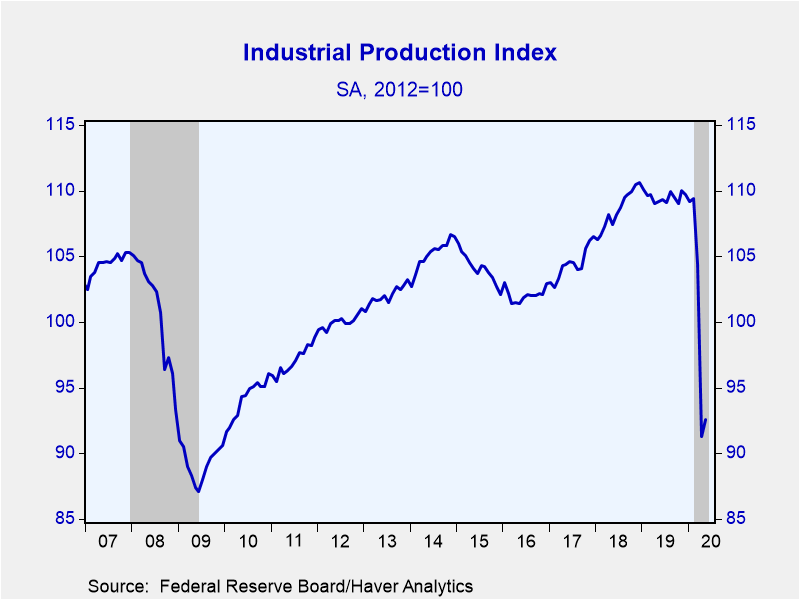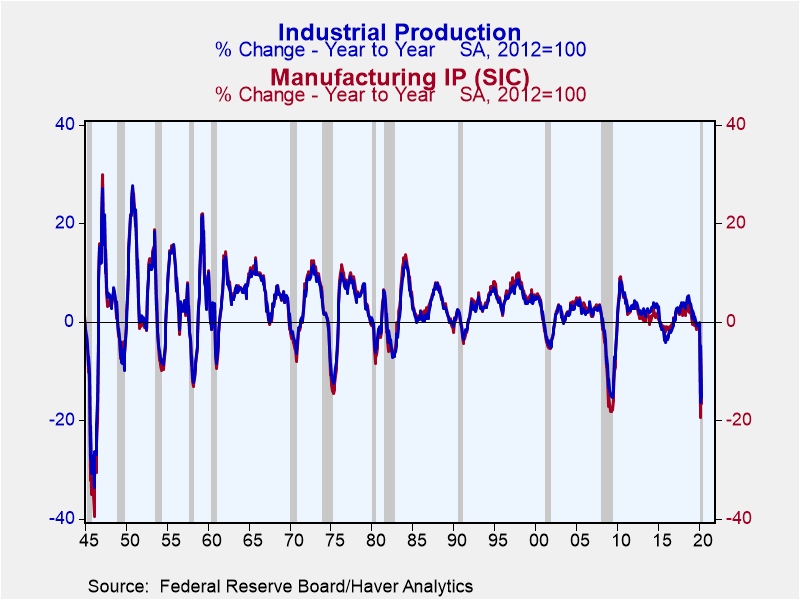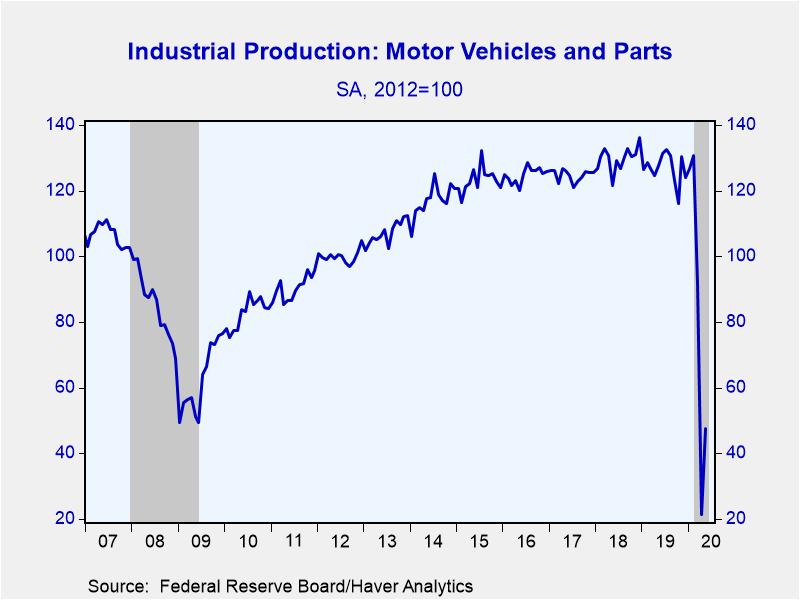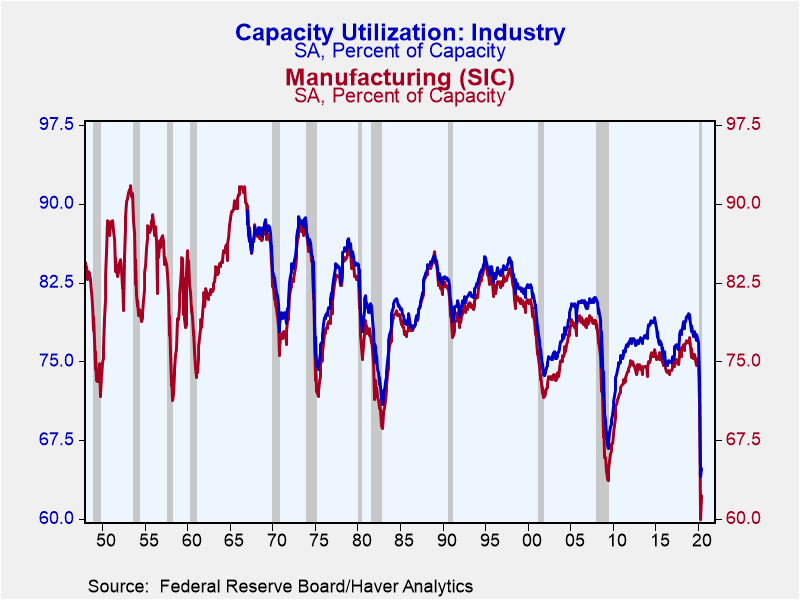 Global| Jun 16 2020
Global| Jun 16 2020U.S. Industrial Production: April Worse, May Better; Output 15.4% Below February
Summary
• Industrial production rose 1.4% in May after a downwardly-revised record 12.5% drop in April. • Manufacturing increased 3.8%; still at 1997 levels. • Motor vehicle output more than doubles but at just 36.4% of February level. [...]
• Industrial production rose 1.4% in May after a downwardly-revised record 12.5% drop in April.
• Manufacturing increased 3.8%; still at 1997 levels.
• Motor vehicle output more than doubles but at just 36.4% of February level.
Industrial production increased 1.4% in May (-15.3% year-on-year) after a downwardly-revised 12.5% record drop in April (was -11.2%). March was also revised down slightly to -4.6% from -4.5%. The Action Economics Survey forecast a 2.9% gain in May. This leaves industrial production 15.4% below February and at 2010 levels. Output is actually lower than the previously-reported April level because the downward revisions to March and particularly April were larger than the gain in May.
Manufacturing production grew 3.8% in May (-16.5% y/y) with April revised down meaningfully (-15.5% versus -13.7%). March was taken down as well (-5.5% vs. -5.3%). This leaves factory output 16.9% below February and at 1997 levels. Utilities declined 2.3% (-8.0% y/y) and mining dropped 6.8% (-14.1% y/y). While the volatility in mining tends to be large as a result of variable commodity prices, the 15.6% drop in the last four months -- emanating from an unprecedented decline in oil prices -- was last seen 71 years ago.
Manufacturing of durable goods jumped 5.8% in May (-23.3% y/y) led by a 120.8% rebound in motor vehicles (-62.8% y/y). Still motor vehicle output is 63.6% below February's level, up from -83.5% in April. The auto sector utilized just 28.4% of its capacity, the second lowest level on record, up from April's 12.8%. Output in other major durable goods industries were mixed: six grew, four contracted and one was unchanged. Nondurable output was up 2.1% (-9.2% y/y) with seven out of eight sectors increasing.
Output of business equipment, an indicator of capital spending, gained 5.8% in May after a record 23.0% drop April. This is the first increase in six months and leaves output 24.9% below February and at 1998 levels.
Capacity utilization rose to 64.8% in May -- the second lowest level on record - up from a downwardly-revised record low of 64.0% in April; data goes back to 1967. The Action Economics Survey expected 66.7% in May. As with the level of output, the utilization rate in May is lower than the previously-reported April level. Factory sector use increased to 62.2% from an unprecedented 60.0%; data goes back to 1948.
Industrial production and capacity and oil prices are located in Haver's USECON database. Additional detail on production and capacity can be found in the IP database. The expectations figures come from the AS1REPNA database.
| Industrial Production (SA, % Change) | May | Apr | Mar | May Y/Y | 2019 | 2018 | 2017 |
|---|---|---|---|---|---|---|---|
| Total Output | 1.4 | -12.5 | -4.6 | -15.3 | 0.9 | 3.9 | 2.3 |
| Manufacturing | 3.8 | -15.5 | -5.3 | -16.5 | -0.2 | 2.3 | 2.0 |
| Durable Goods | 5.8 | -21.6 | -7.7 | -23.3 | 0.7 | 3.4 | 2.2 |
| Motor Vehicles | 120.8 | -76.5 | -30.0 | -62.8 | -2.4 | 4.1 | 0.0 |
| Selected High Tech | -0.7 | -4.2 | -0.6 | -0.2 | 5.1 | 6.4 | 2.6 |
| Nondurable Goods | 2.1 | -9.6 | -2.6 | -9.2 | -0.7 | 1.9 | 1.9 |
| Utilities | -2.3 | 0.1 | -3.1 | -8.0 | -0.8 | 4.4 | -0.8 |
| Mining | -6.8 | -6.1 | -1.9 | -14.1 | 7.1 | 12.4 | 7.4 |
| Capacity Utilization (%) | 64.8 | 64.0 | 73.2 | 77.8 | 77.8 | 78.7 | 76.5 |
| Manufacturing | 62.2 | 60.0 | 71.1 | 75.4 | 75.6 | 76.6 | 75.1 |
Gerald D. Cohen
AuthorMore in Author Profile »Gerald Cohen provides strategic vision and leadership of the translational economic research and policy initiatives at the Kenan Institute of Private Enterprise.
He has worked in both the public and private sectors focusing on the intersection between financial markets and economic fundamentals. He was a Senior Economist at Haver Analytics from January 2019 to February 2021. During the Obama Administration Gerald was Deputy Assistant Secretary for Macroeconomic Analysis at the U.S. Department of Treasury where he helped formulate and evaluate the impact of policy proposals on the U.S. economy. Prior to Treasury, he co-managed a global macro fund at Ziff Brothers Investments.
Gerald holds a bachelor’s of science from the Massachusetts Institute of Technology and a Ph.D. in Economics from Harvard University and is a contributing author to 30-Second Money as well as a co-author of Political Cycles and the Macroeconomy.









